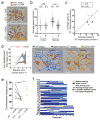The impact of negative selection on thymocyte migration in the medulla
- PMID: 19543275
- PMCID: PMC2793676
- DOI: 10.1038/ni.1761
The impact of negative selection on thymocyte migration in the medulla
Abstract
Developing thymocytes are screened for self-reactivity before they exit the thymus, but how thymocytes scan the medulla for self antigens is unclear. Using two-photon microscopy, we observed that medullary thymocytes migrated rapidly and made frequent, transient contacts with dendritic cells. In the presence of a negative selecting ligand, thymocytes slowed, became confined to areas of approximately 30 microm in diameter and had increased contact with dendritic cells surrounding confinement zones. One third of polyclonal medullary thymocytes also showed confined, slower migration and may correspond to autoreactive thymocytes. Our data suggest that many autoreactive thymocytes do not undergo immediate arrest and death after encountering a negative selecting ligand but instead adopt an altered migration program while remaining in the medullary microenvironment.
Figures





Comment in
-
Dead man walking: how thymocytes scan the medulla.Nat Immunol. 2009 Aug;10(8):809-11. doi: 10.1038/ni0809-809. Nat Immunol. 2009. PMID: 19621041 No abstract available.
References
-
- Kyewski B, Klein L. A central role for central tolerance. Annu Rev Immunol. 2006;24:571–606. - PubMed
-
- Anderson MS, et al. Projection of an immunological self shadow within the thymus by the aire protein. Science. 2002;298:1395–1401. - PubMed
-
- Mathis D, Benoist C. Aire. Annu Rev Immunol. 2009;27:287–312. - PubMed
-
- Derbinski J, Schulte A, Kyewski B, Klein L. Promiscuous gene expression in medullary thymic epithelial cells mirrors the peripheral self. Nat Immunol. 2001;2:1032–1039. - PubMed
-
- Anderson MS, et al. The cellular mechanism of Aire control of T cell tolerance. Immunity. 2005;23:227–239. - PubMed
MeSH terms
Substances
Grants and funding
LinkOut - more resources
Full Text Sources
Other Literature Sources

